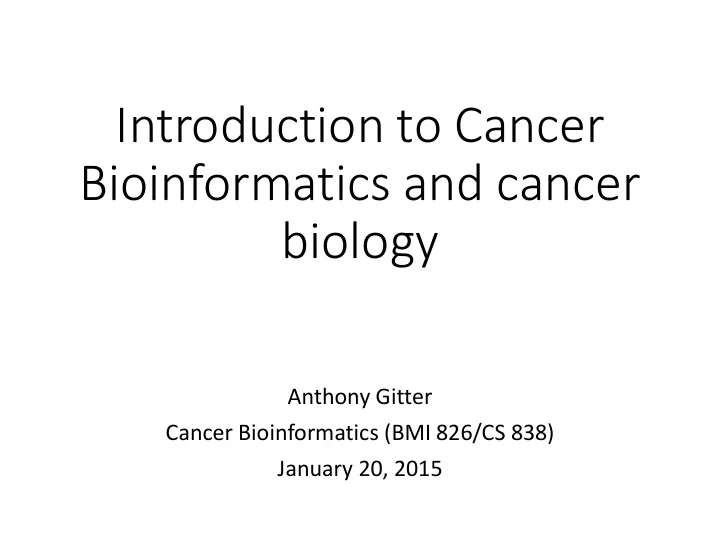

Introduction to Cancer Bioinformatics and cancer biology Anthony Gitter Cancer Bioinformatics (BMI 826/CS 838) January 20, 2015
Why cancer bioinformatics? • Devastating disease, no cure on the horizon • Major focus of large-scale genomics efforts • Abundant data, interpretation is the challenge • Problem is complex data not “big data” • Real impact on basic and translational research • Heavy computational components to high-profile biology papers • Purely computational/statistical papers can have impact • January 2, 2015 in Science Tomasetti2015
Caveats in cancer bioinformatics • 27173 “cancer bioinformatics” papers in PubMed 4000 > 10/day 3500 Articles published 3000 2500 2000 1500 1000 500 0 1987 1988 1989 1990 1991 1992 1993 1994 1995 1996 1997 1998 1999 2000 2001 2002 2003 2004 2005 2006 2007 2008 2009 2010 2011 2012 2013 2014 2015 Year • Easy to make predictions, hard to support them • Many genes have some relation to cancer
Introductions • Professor Anthony Gitter • Assistant professor in Biostatistics and Medical Informatics • Affiliate faculty in Computer Sciences • Investigator in Morgridge Institute • Class introductions • Home department • Background (BMI/CS 576?) • Research • Interest in Cancer Bioinformatics
Course overview • Interactive discussions of research papers • Grades • Presentation and discussion of research papers: 60% • Project: 40% • No textbook • Office hours by appointment • Review syllabus at https://www.biostat.wisc.edu/~gitter/BMI826-S15
Presentations • Journal club/reading group style presentations • Minimal slides • Figures or equations from paper • May require reading some referenced papers • Your thoughts on areas for improvement or future work • Schedule online later today
Project • Experience making real predictions with real data • Groups of 2-3 students • Ideas will be presented in class • Tentative schedule • 2/24: Ideas presented • 3/10: Proposals due • 4/9: Status report due • 5/7: In class presentations • 5/11: Reports due
What is cancer? • Normal cells acquire deficiencies • Grow and divide more than their peer normal cells • Overcome body’s defense mechanisms • Over time, become increasingly abnormal, invasive, and detrimental
Causes of cancer • Germline genetics • Predisposition due to inherited DNA • E.g. BRCA1/BRCA2 mutations increase risk of breast and ovarian cancer • Environmental factors • Carcinogens: smoke, asbestos, UV radiation • Viruses • Somatic alterations • E.g. non-inherited DNA mutations • Recent estimates (Tomasetti2015) that 65% of differences in cancer risk explained by errors in DNA replication (stem cell division)
DNA damage HHMI BioInteractive
DNA replication HHMI BioInteractive
Variation in cancer risk among tissues can be explained by the number of stem cell divisions Environmental/inherited Replication-associated Tomasetti2015
Causes of cancer continued • Causes include: • Germline genetics • Environmental factors • Somatic alterations • Specific causes have the same net effect • Confer a growth advantage upon the mutated or altered cells
Basic units of a genome and cell NLM Handbook
Transcription HHMI BioInteractive
Signaling Vogelstein2013
Abstracting transcriptional and signaling networks • Transcriptional regulation TRED • Signaling pathway KEGG
Types of genomic abnormalities • DNA mutations • Silent : do not change amino acid • Missense : modified codon creates new amino acid • Nonsense : premature stop codon, truncates protein • Insertion/deletion (indel) • Copy number changes • Amplifications • Deletions • Translocations (gene fusions)
Number of somatic mutations Vogelstein2013
Detecting genomic alterations Ding2014
Other types of perturbations • Not all mutations directly affect coding sequence of a gene • Splicing • Transcription • Chain reactions along pathways and networks • Epigenetic : Changes in gene expression or cellular phenotype caused by mechanisms other than changes in the DNA sequence (Vogelstein2013) • DNA methylation
Promoter mutations Patton2013
Cancer progression • Mutations accumulate over time • More environmental exposures • More DNA replication cycles • Benign tumor -> malignant tumor -> metastasis • Cancer stages (Cancer Institute): • Stage 0 : Local tumor in tissue of origin • Stage 1 : Invades neighboring tissue • Stage 2/3 : Regional spread, lymph nodes • Stage 4 : Distant spread
Barriers to treating cancer • Distinguishing root cause • Several types of heterogeneity • Redundancy of signaling pathways, resiliency to treatment • Metastasis
Driver vs. passenger • Cancer cells disable DNA protection mechanisms • Acquire many more mutations • Most of them are not causal • Driver : Confers selective growth advantage • Passenger : No impact on growth • Recent estimates ~100s of drivers across cancers • 138 (Vogelstein2013) • 291 (Tamborero2013)
Distinguishing driver vs. passenger • Strategies for identifying the driver mutations (Ding2014) • Recurrence and frequency assessment • Variant effect prediction • Pathway or network analysis
Oncogenes vs. tumor suppressors • Oncogene : mutation activates, increases selective growth advantage • Tumor suppressor: mutation inactivates (often truncates), increases selective growth advantage Vogelstein2013
Types of heterogeneity Vogelstein2013
Tumor evolution Ding2014
Tumors are mixtures of cell types Hanahan2011
Convergence of driver events • Amid the complexity and heterogeneity, there is some order • Finite number of major pathways that are affected by drivers Vogelstein2013 Hanahan2011
Similar pathway effects • Tumor 1: EGFR receptor mutation makes it hypersensitive • Tumor 2: KRAS hyperactive • Tumor 3: NF1 inactivated and no longer modulates KRAS • Tumor 4: BRAF over responsive to KRAS signals Vogelstein2013
References and glossary • Material in these slides based upon • Hanahan2011 • Vogelstein2013 • Ding2014 • Vogelstein2013 contains an excellent glossary of cancer terms
Recommend
More recommend